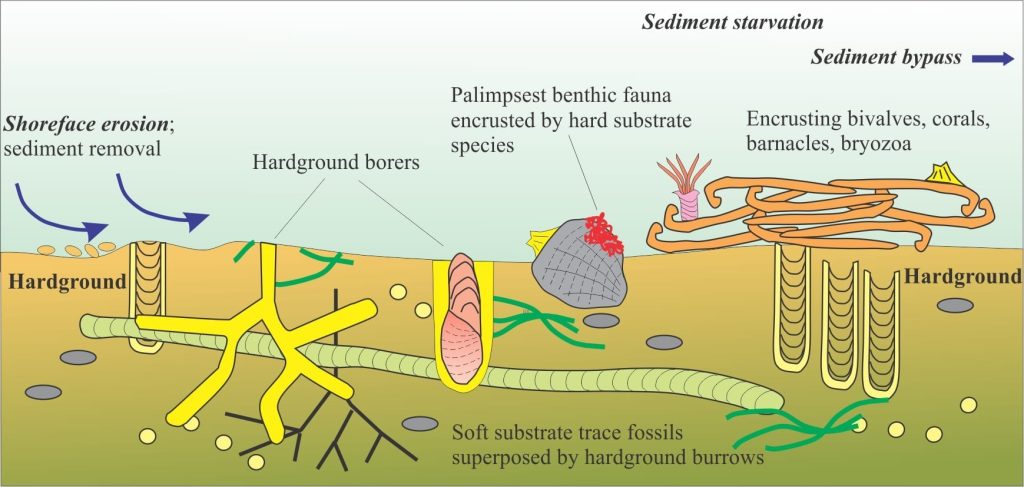
Condensed sections record multifarious interactions of physical, biological, and geochemical processes played out over long time spans, all condensed into a few very thin beds.
The stratigraphic record is anything but continuous. We know that unconformities and disconformities represent missing geological time, significant gaps where the rock record either never developed or was removed by erosion. But what about the rest of the stratigraphic record? How complete is it?
Andrew Miall (2014) refers to the “emptiness of the stratigraphic record”, echoing Ager’s (1973) earlier comment that the “sedimentary record is more gap than record “. Take your average shallow marine, turbidite, or fluvial succession. At the most basic, bedding planes represent breaks in sedimentation, breaks that might be measured in minutes or centuries. Likewise, fluvial channel deposits that are replete with cross-cutting bedforms might represent 10s to 100s of years accumulation and yet we are only witnessing the final acts of preservation, wherein the record of all previous channel bedforms exists only in the facies models we derive. Miall’s assessment of the Late Cretaceous Mesaverde Group indicates that the actual record of deposition exposed in Book Cliffs may be as little as 10% of its 4.86 million-year duration.
Condensed sections are a special kind of ‘stratigraphic incompleteness’. Kidwell (1993), and a more recent review by Föllmi (2016 – who also provides a list of well-known examples), define a condensed section as:
- Very thin units (decimetres) relative to
- The span of time they represent (105 to 107 years). For example, the fossiliferous Late Oligocene Kokoamu Greensand in southern New Zealand, is commonly 1-5 m thick but represents a time span of about 4 million years.
- Containing a biota representative of the span of time, meaning that over a period of 106 years, several faunal or floral biozones may be present. However, the paleontological record may be complicated by postmortem mixing, commonly by bioturbation.
- Containing internal discordances and hiatuses caused by erosion or non-deposition. Bedload transport and erosion of sediment on the sea floor is typical of shoreface dynamics on siliciclastic shelves and carbonate platforms. Non-deposition may be due to sediment starvation (other than fine particles in suspension), for example during transgression when river supply is thwarted by rising baselevels; or situations where sediment bypasses a shelf or platform on its way to deeper waters.
- Containing abundant authigenic minerals (i.e. precipitated at or close to the sea floor) such as carbonate, phosphate, silica (chert), glaucony (glauconite green sands), manganese and iron oxides.
- Hardgrounds are common sites of condensation. Examples include carbonate hardgrounds on shallow carbonate platforms, that also provide domicile to boring and entrusting organisms; iron-manganese hardgrounds and nodules at much greater bathyal to abyssal depths, and phosphate nodules or hardgrounds in regions of nutrient upwelling.
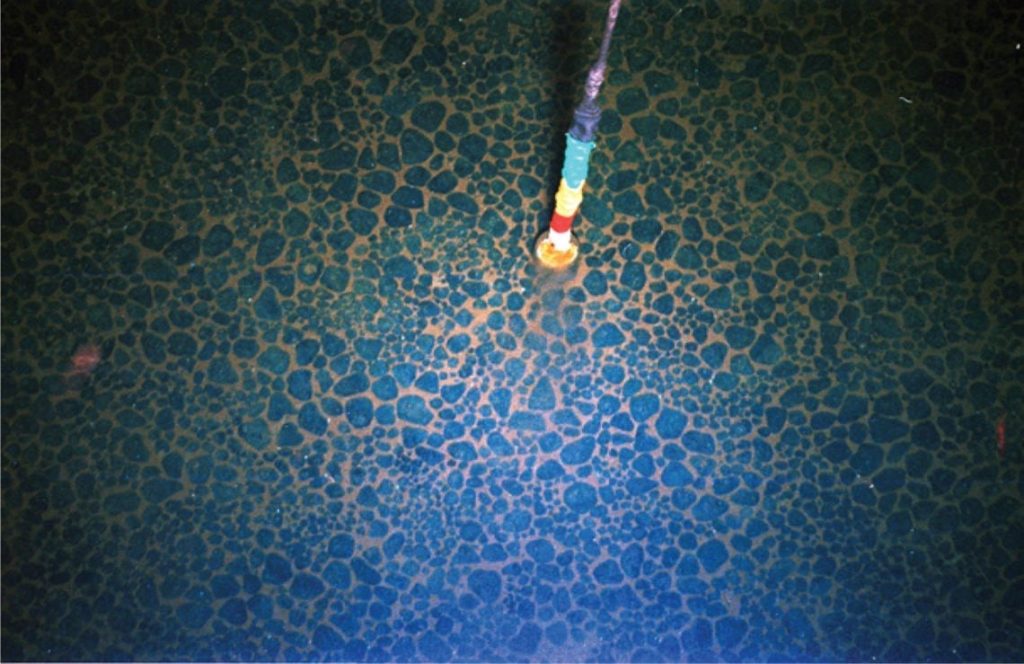
The most likely place you will see a condensed section is in outcrop or core. The common array of wireline logging tools may also help identify these units, based on elevated gamma response (for example, responding to the elevated potassium in glauconite), or abrupt changes in density in sonic and density logs across hardgrounds.
Omission surfaces
Stratigraphic surfaces swept bare by erosion or starved of sediment are commonly referred to as omission surfaces. Omission surfaces are important components of condensed stratigraphic sections. Although not a necessary condition, the term is commonly reserved for surfaces that have been modified by benthic organisms; examples include encrusting molluscs such as oysters, bryozoa, corals, barnacles, and calcareous algae (e.g. Lithothamnion), plus critters that are capable of boring through firm or cemented sediment.
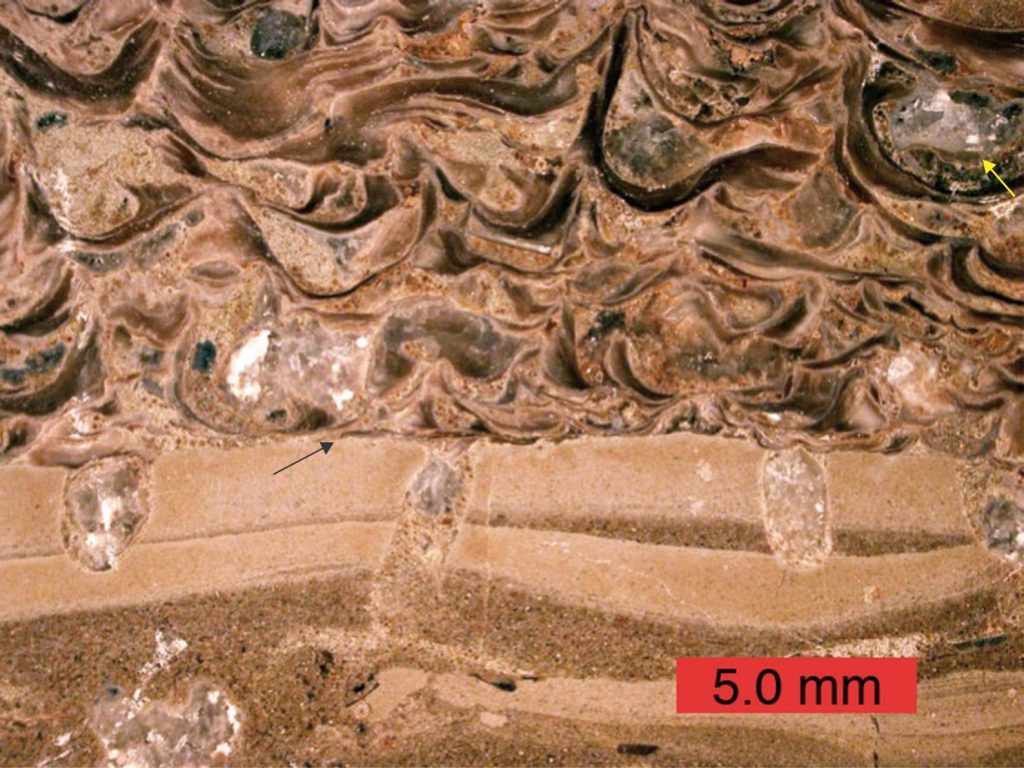
Omission surfaces commonly develop on hardgrounds and firmgrounds, that also harbour specialized trace fossil assemblages, particularly those that can bore through cemented sediment. More specifically they are called ichnological omission surfaces. MacEachen et al (2012) listed several diagnostic criteria to help identify these surface (note that some of the criteria taken individually are common to many non-omission trace fossil suites, but taken collectively are convincing):
- Trace fossils cut across sedimentary structures and other trace fossils; borings may also transect earlier-deposited or cemented shells.
- If the boring organism is a shelly mollusc, such as a pholad bivalve, then preservation of the organism within its home is possible (unlike most other trace fossils). The bored hole will also fill be filled by sediment from the exposed surface.
- Traces are unlined but may show wall markings such as scratches.
- Hardgrounds are less likely to encourage critters that prefer soft substrates.
- Burrows in hardgrounds are less likely to compact during sediment burial.
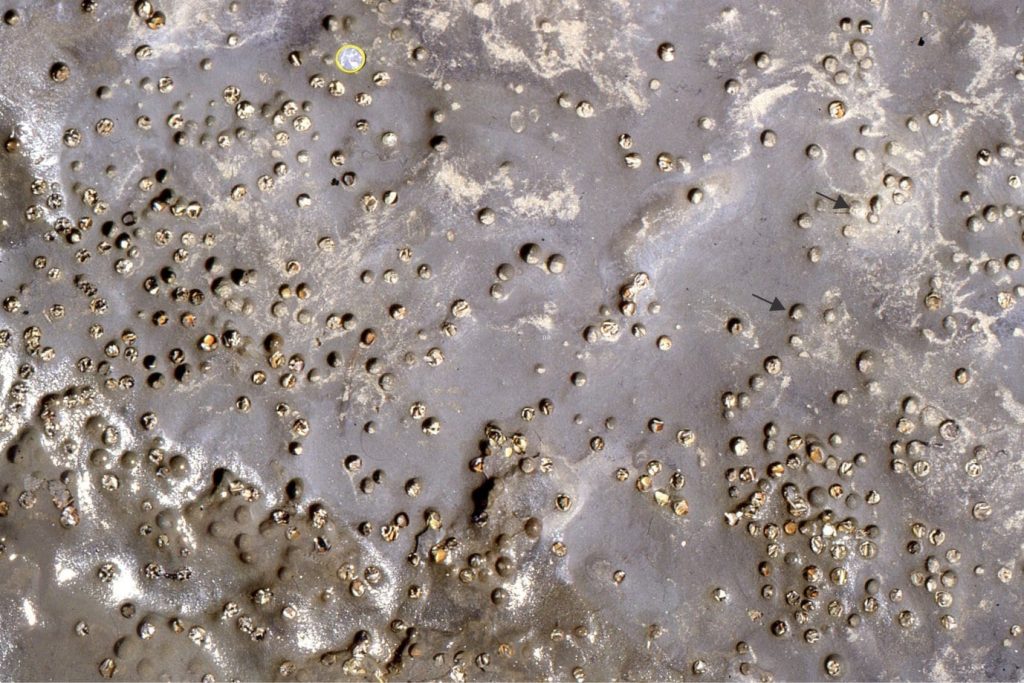
A condensed section from the Middle Jurassic Bowser Basin
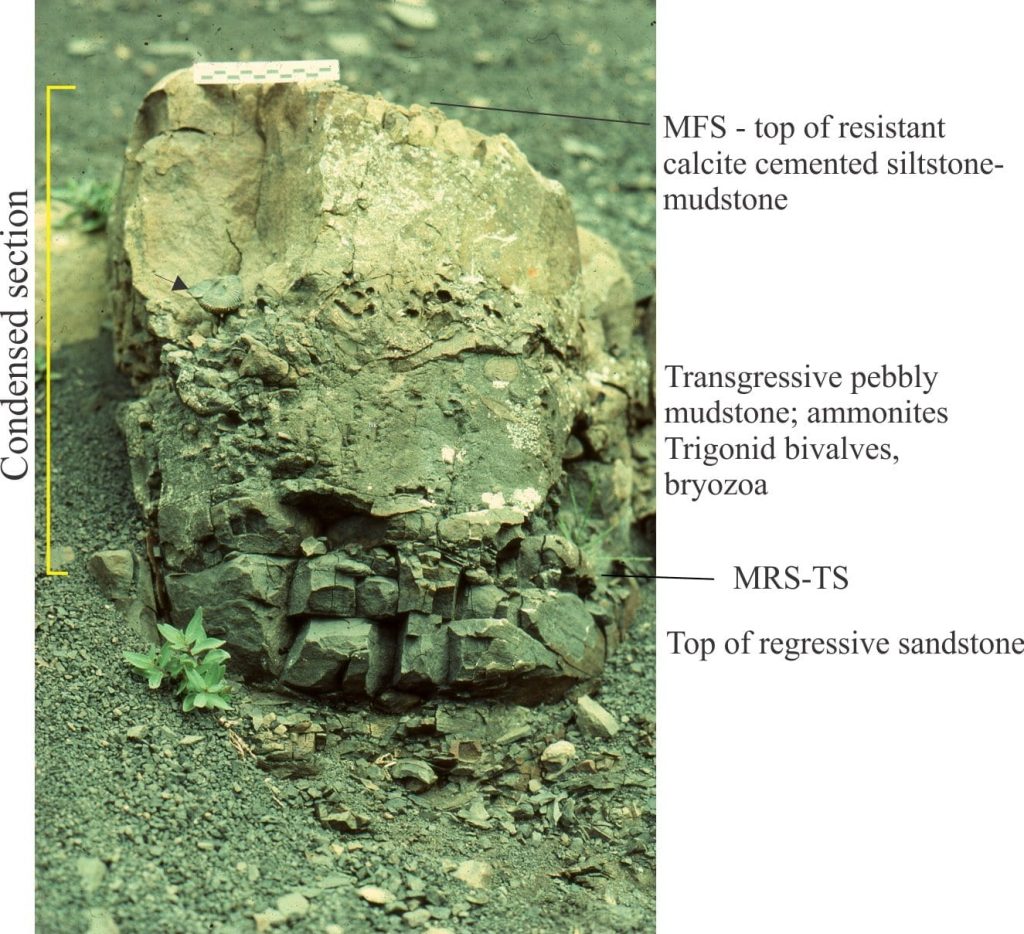
In this coarsening-upward parasequence, shoreface sandstones are terminated by a surface of maximum regression (MRS) above which are thin transgressive deposits. The preserved record of transgression is little more than 0.5 metre of thick, between the MRS and a flooding surface (MFS), but probably represents a passage of time the same order-of-magnitude as the underlying regressive portion of the parasequence. Thus, the record of transgression is condensed; it consists of two main components:
- A fossiliferous, pebbly, sandy mudstone that overlies the MRS, and represents the reworking of coarse sediment, bivalves and ammonites left on the sea floor at the end of regression. Little new sediment was introduced to the sea floor at this time, other than some mud from suspension, i.e. the sea floor was essentially starved of new sediment. Some shells are encrusted with bryozoa that may have grown on the reworked debris.
- Sediment starvation continued and calcite precipitated within the uppermost mud and silt. This component of the condensed section is overlain by the maximum flooding surface (MFS), that in turn is overlain by several metres of mud, silt and fine sand that herald the return to regression.
Condensed sections are fascinating in and of themselves because…
They are stratigraphically skinny, and yet they record the multifarious interactions of physical, biological, and geochemical processes, played out over long periods. They also contribute to stratigraphic analysis:
- They indicate dramatic changes in sediment flux.
- They frequently contain evidence for dramatic changes in biota, for example the shifting demographics of organisms as soft substrates transition to hardgrounds.
- They help define key stratigraphic surfaces such as subaerial unconformities, the maximum regressive surface, and transgressive flooding surfaces and, therefore, changes in baselevel.
- They help define clinoform lapout, for example along surfaces of (transgressive) onlap and (regressive) downlap.
- They are useful stratigraphic markers within basins, and in some cases between sedimentary basins.
This post is part of the How To…series on Stratigraphy and Sequence Stratigraphy
Other posts in this series on Stratigraphy and Sequence Stratigraphy
Stratigraphic surfaces in outcrop – baselevel fall
Stratigraphic surfaces in outcrop – baselevel rise
A timeline of stratigraphic principles; 15th to 18th C
A timeline of stratigraphic principles; 19th C to 1950
A timeline of stratigraphic principles; 1950-1977
Baselevel, Base-level, and Base level
Sediment accommodation and supply
Autogenic or allogenic dynamics in stratigraphy?
Stratigraphic cycles: What are they?
Sequence stratigraphic surfaces
Shorelines and shoreline trajectories
Stratigraphic trends and stacking patterns

















